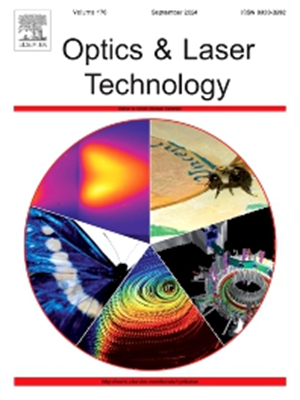集成散斑去噪的大景深结构光三维微尺度测量系统
IF 5
2区 物理与天体物理
Q1 OPTICS
引用次数: 0
摘要
工业制造对高精度、高效率和低成本检测技术的需求日益增长,推动了三维测量系统的重大进步。结构光测量是一种非接触的、经济有效的三维测量方法,由于其简单、快速的测量能力而得到了广泛的应用。然而,将结构光应用于微观场景存在挑战,特别是由于光学系统的限制导致的景深有限。为了解决这个问题,现有的方法主要集中在景深的物理或虚拟扩展上,每种方法都有固有的局限性,例如复杂的校准、降低的效率和对系统参数的敏感性。本文介绍了一种利用数字全息重聚焦原理的新型扩展景深显微结构光测量系统。通过离轴全息术,每个深度平面的光场信息被捕获,使得散焦条纹的精确重建成为可能。为了减轻相干光源散斑噪声的不利影响,提出了一种基于残差卷积神经网络的去噪方法,利用模拟数据集进行训练。实验结果表明,该系统在具有粗糙表面的小样本以及具有突然高度变化的物体(如阶梯结构)的三维测量中具有高精度和高效率的有效性。此外,它能够处理重要的材料多样性-例如陶瓷,哑光金属和低反射率金属组件-突出了其广泛的工业应用的强大潜力。本文章由计算机程序翻译,如有差异,请以英文原文为准。
Large depth-of-field structured light system for 3D microscale measurement with integrated speckle denoising
The increasing demand for high-precision, high-efficiency, and low-cost inspection technologies in industrial manufacturing has driven significant advancements in three-dimensional measurement systems. Structured light measurement, a non-contact and cost-effective three-dimensional measurement method, is widely utilized due to its simplicity and rapid measurement capabilities. However, applying structured light to microscopic scenarios presents challenges, particularly due to limited depth of field caused by the constraints of optical systems. To address this, existing approaches have focused on either physical or virtual extensions of depth of field, each with inherent limitations, such as complex calibration, reduced efficiency, and sensitivity to system parameters. This paper introduces a novel microscopic structured light measurement system with an extended depth of field, leveraging the principle of digital holographic refocusing. Through off-axis holography, light field information from each depth plane is captured, enabling precise reconstruction of defocused fringes. To mitigate the adverse effects of speckle noise from coherent light sources, a residual convolutional neural network-based denoising method is proposed, utilizing simulated datasets for training. Experimental results demonstrate the system’s effectiveness in achieving high accuracy and efficiency in three-dimensional measurements of small samples with rough surfaces as well as for objects exhibiting abrupt height variations such as step-like structures. Additionally, its capability to handle significant material diversity—such as ceramics, matte metals, and low-reflectivity metallic components—highlighting its strong potential for a wide range of industrial applications.
求助全文
通过发布文献求助,成功后即可免费获取论文全文。
去求助
来源期刊
CiteScore
8.50
自引率
10.00%
发文量
1060
审稿时长
3.4 months
期刊介绍:
Optics & Laser Technology aims to provide a vehicle for the publication of a broad range of high quality research and review papers in those fields of scientific and engineering research appertaining to the development and application of the technology of optics and lasers. Papers describing original work in these areas are submitted to rigorous refereeing prior to acceptance for publication.
The scope of Optics & Laser Technology encompasses, but is not restricted to, the following areas:
•development in all types of lasers
•developments in optoelectronic devices and photonics
•developments in new photonics and optical concepts
•developments in conventional optics, optical instruments and components
•techniques of optical metrology, including interferometry and optical fibre sensors
•LIDAR and other non-contact optical measurement techniques, including optical methods in heat and fluid flow
•applications of lasers to materials processing, optical NDT display (including holography) and optical communication
•research and development in the field of laser safety including studies of hazards resulting from the applications of lasers (laser safety, hazards of laser fume)
•developments in optical computing and optical information processing
•developments in new optical materials
•developments in new optical characterization methods and techniques
•developments in quantum optics
•developments in light assisted micro and nanofabrication methods and techniques
•developments in nanophotonics and biophotonics
•developments in imaging processing and systems

 求助内容:
求助内容: 应助结果提醒方式:
应助结果提醒方式:


